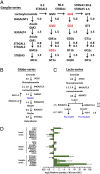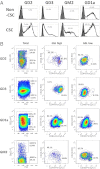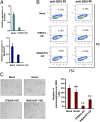Differential expression profiles of glycosphingolipids in human breast cancer stem cells vs. cancer non-stem cells
- PMID: 23479608
- PMCID: PMC3612608
- DOI: 10.1073/pnas.1302825110
Differential expression profiles of glycosphingolipids in human breast cancer stem cells vs. cancer non-stem cells
Abstract
Previous studies demonstrated that certain glycosphingolipids (GSLs) are involved in various cell functions, such as cell growth and motility. Recent studies showed changes in GSL expression during differentiation of human embryonic stem cells; however, little is known about expression profiles of GSLs in cancer stem cells (CSCs). CSCs are a small subpopulation in cancer and are proposed as cancer-initiating cells, have been shown to be resistant to numerous chemotherapies, and may cause cancer recurrence. Here, we analyzed GSLs expressed in human breast CSCs by applying a CSC model induced through epithelial-mesenchymal transition, using mass spectrometry, TLC immunostaining, and cell staining. We found that (i) Fuc-(n)Lc4Cer and Gb3Cer were drastically reduced in CSCs, whereas GD2, GD3, GM2, and GD1a were greatly increased in CSCs; (ii) among various glycosyltransferases tested, mRNA levels for ST3GAL5, B4GALNT1, ST8SIA1, and ST3GAL2 were increased in CSCs, which could explain the increased expression of GD3, GD2, GM2, and GD1a in CSCs; (iii) the majority of GD2+ cells and GD3+ cells were detected in the CD44(hi)/CD24(lo) cell population; and (iv) knockdown of ST8SIA1 and B4GALNT1 significantly reduced the expression of GD2 and GD3 and caused a phenotype change from CSC to a non-CSC, which was detected by reduced mammosphere formation and cell motility. Our results provide insight into GSL profiles in human breast CSCs, indicate a functional role of GD2 and GD3 in CSCs, and suggest a possible novel approach in targeting human breast CSCs to interfere with cancer recurrence.
Conflict of interest statement
The authors declare no conflict of interest.
Figures





References
-
- Handa K, Hakomori SI. Carbohydrate to carbohydrate interaction in development process and cancer progression. Glycoconj J. 2012;29(8-9):627–637. - PubMed
-
- International Union of Pure and Applied Chemistry and International Union of Biochemistry Commission on Biochemical Nomenclature The nomenclature of lipids. Recommendations 1976. Lipids. 1977;12(6):455–468. - PubMed
-
- Svennerholm L. The Gangliosides. J Lipid Res. 1964;5:145–155. - PubMed
Publication types
MeSH terms
Substances
LinkOut - more resources
Full Text Sources
Other Literature Sources
Medical
Miscellaneous

